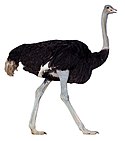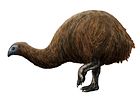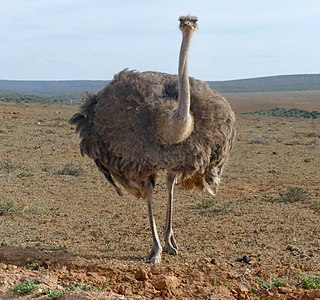
Struthioniformes is an order of birds with only a single extant family, Struthionidae, containing the ostriches. Several other extinct families are known, spanning across the Northern Hemisphere, from the Early Eocene to the early Pliocene, including a variety of flightless forms like the Paleotididae, Geranoididae, Eogruidae and Ergilornithidae, the latter two thought to be closely related to Struthionidae.

Falcons are birds of prey in the genus Falco, which includes about 40 species. Some small species of falcons with long, narrow wings are called hobbies, and some that hover while hunting are called kestrels. Falcons are widely distributed on all continents of the world except Antarctica, though closely related raptors did occur there in the Eocene.
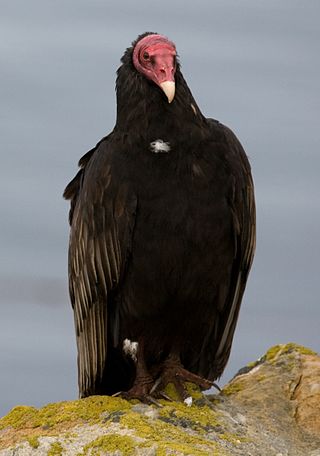
Cathartidae, known commonly as New World vultures or condors, are a family of birds of prey consisting of seven extant species in five genera. It includes five extant vultures and two extant condors found in the Americas. They are known as "New World" vultures to distinguish them from Old World vultures, with which the Cathartidae does not form a single clade despite the two being similar in appearance and behavior as a result of convergent evolution.
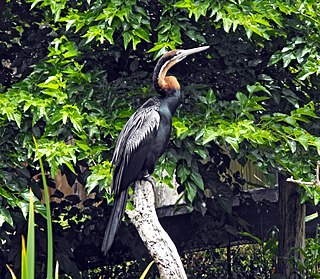
The darters, anhingas, or snakebirds are mainly tropical waterbirds in the family Anhingidae, which contains a single genus, Anhinga. There are four living species, three of which are very common and widespread while the fourth is rarer and classified as near-threatened by the IUCN. The term snakebird is usually used without any additions to signify whichever of the completely allopatric species occurs in any one region. It refers to their long thin neck, which has a snake-like appearance when they swim with their bodies submerged, or when mated pairs twist it during their bonding displays. "Darter" is used with a geographical term when referring to particular species. It alludes to their manner of procuring food, as they impale fishes with their thin, pointed beak. The American darter is more commonly known as the anhinga. It is sometimes called "water turkey" in the southern United States; though the anhinga is quite unrelated to the wild turkey, they are both large, blackish birds with long tails that are sometimes hunted for food.

The Anatidae are the biological family of water birds that includes ducks, geese, and swans. The family has a cosmopolitan distribution, occurring on all the world's continents except Antarctica. These birds are adapted for swimming, floating on the water surface, and, in some cases, diving in at least shallow water. The family contains around 174 species in 43 genera.

Phalacrocoracidae is a family of approximately 40 species of aquatic birds commonly known as cormorants and shags. Several different classifications of the family have been proposed, but in 2021 the International Ornithologists' Union (IOU) adopted a consensus taxonomy of seven genera. The great cormorant and the common shag are the only two species of the family commonly encountered in Britain and Ireland and "cormorant" and "shag" appellations have been later assigned to different species in the family somewhat haphazardly.

Rheidae is a family of flightless ratite birds which first appeared in the Paleocene. It is today represented by the sole living genus Rhea, but also contains several extinct genera.

Colubridae is a family of snakes. With 249 genera, it is the largest snake family. The earliest fossil species of the family date back to the Late Eocene epoch, with earlier origins suspected. Colubrid snakes are found on every continent except Antarctica.

The black geese of the genus Branta are waterfowl belonging to the true geese and swans subfamily Anserinae. They occur in the northern coastal regions of the Palearctic and all over North America, migrating to more southerly coasts in winter, and as resident birds in the Hawaiian Islands. Alone in the Southern Hemisphere, a self-sustaining feral population derived from introduced Canada geese is also found in New Zealand.
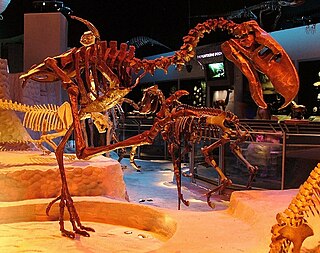
Phorusrhacids, colloquially known as terror birds, are an extinct family of large carnivorous, mostly flightless birds that were among the largest apex predators in South America during the Cenozoic era. Their definitive fossil records range from the Middle Eocene to the Late Pleistocene around 43 to 0.1 million years ago, though some specimens suggest that they were present since the Early Eocene.

Mesembriornis is a genus of intermediate-sized phorusrhacids that grew up to 1.5 metres (4.9 ft) in height. They represent a well-distinct lineage of terror birds, differing from the massive large groups and the smaller Psilopterinae. In general proportions, they most resembled the Patagornithinae which flourished somewhat earlier, mainly to the south of the range of Mesembriornis. Fossils of the terror bird have been found in Montehermosan deposits of the Monte Hermoso Formation, as well as the Andalgala Formation and Chapadmalal Formation in Argentina.
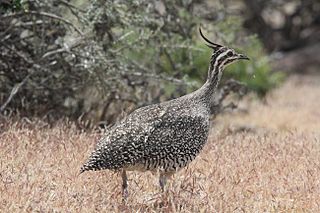
Eudromia is a genus of birds in the tinamou family. This genus comprises two crested members of this South American family.
Aratinga vorohuensis is a prehistoric relative of the nanday parakeet described from Late Pliocene fossils found in and named after the Vorohué Formation of Buenos Aires Province, Argentina.
Heterorhea is an extinct genus of ratites in the rhea family. The type species is H. dabbenei. from the Late Pliocene Monte Hermoso Formation, Buenos Aires, Argentina. The holotype of the genus is missing.

Devincenzia is an extinct genus of giant flightless predatory birds in the family Phorusrhacidae or "terror birds" that lived during the Early Miocene (Deseadan) Fray Bentos Formation of Uruguay, Late Miocene (Huayquerian) Ituzaingó Formation, Early Pliocene (Montehermosan) of Argentina, and possibly the Early Pleistocene Raigón Formation of Uruguay. The type species D. pozzi was formerly known as Onactornis pozzi. The largest possible specimen weighed up to 350 kilograms (770 lb), making it one of the largest phorusrhacids and carnivorous birds known.

Skeletal pneumaticity is the presence of air spaces within bones. It is generally produced during development by excavation of bone by pneumatic diverticula from an air-filled space, such as the lungs or nasal cavity. Pneumatization is highly variable between individuals, and bones not normally pneumatized can become pneumatized in pathological development.
Marplesornis novaezealandiae, also referred to as Harris's penguin, is a genus and species of extinct penguin from New Zealand. It was a relatively large penguin, about the same size as a king penguin. The age of the only known specimen is uncertain, being often mentioned as Late Pliocene in age. However, due to the complex geology of the collection site, its actual age is somewhere between Early Miocene and Late Pliocene.

Llallawavis scagliai is a large, extinct predatory bird from Pliocene Argentina. Its fossil is the most complete fossil of a phorusrhacid yet found.
Uquiasaurus is an extinct genus of iguanian lizards represented by the type species Uquiasaurus heptanodonta from the Late Pliocene of Argentina. Uquiasaurus was first described in 2012 on the basis of isolated snout and jaw bones within the Uquía Formation, the namesake of the genus. These bones were preserved in a midden of predatory bird pellets and are part of a microvertebrate assemblage that includes the bones of rodents, marsupials, frogs, birds, and other lizards, one of the few to document the mixing of North and South American faunas during the Great American Interchange. Phylogenetic analysis indicates that Uquiasaurus is part of a clade of iguanians that includes the living families Liolaemidae, Leiocephalidae, and Tropiduridae. The status of U. heptanodonta as a valid taxon was contested by Scanferla & Díaz-Fernández (2023), who reinterpreted the type series of this species as a fossil bone assemblage composed by more than one species of Liolaemus. Below is a cladogram from Daza et al. (2012) showing its phylogenetic relationships:
This archosaur paleontology list records new fossil archosauriform taxa that were described during the year 2016, as well as notes other significant Archosaur paleontology discoveries and events which occurred during the year.















